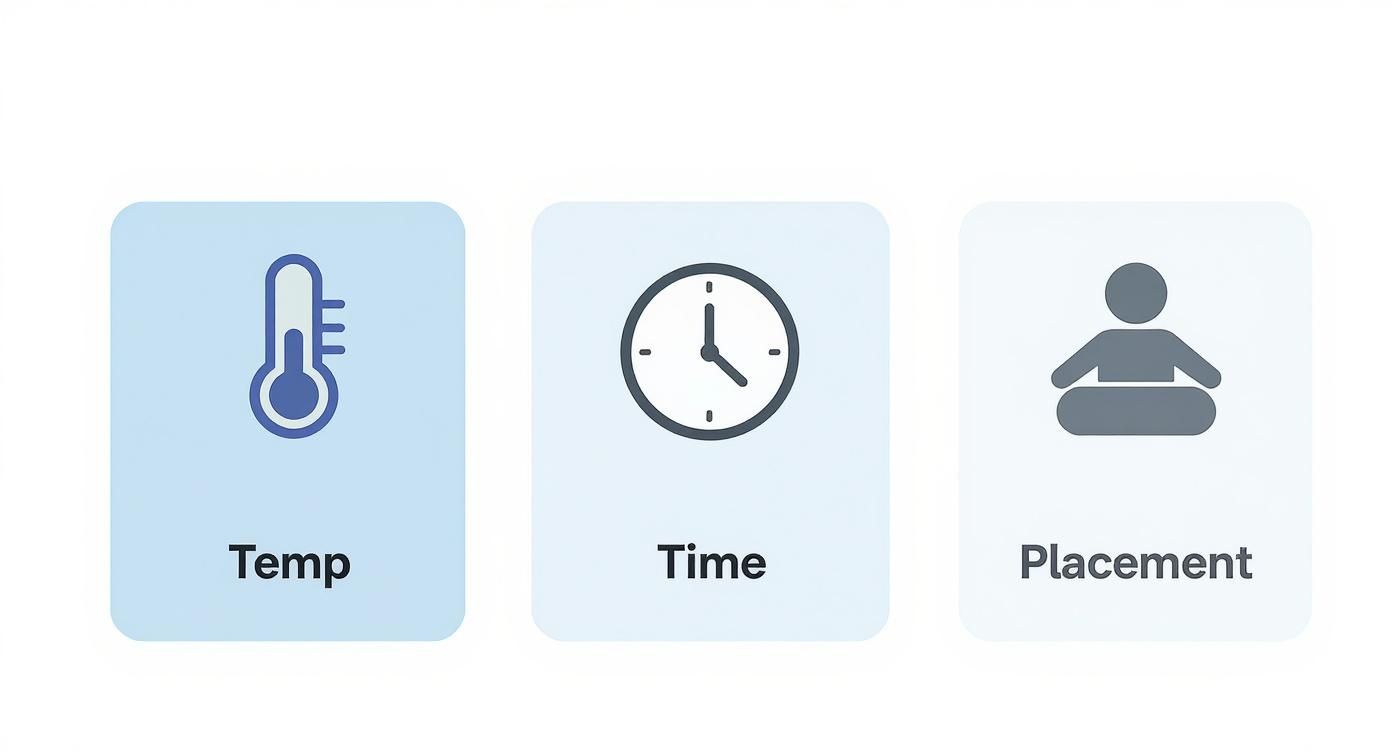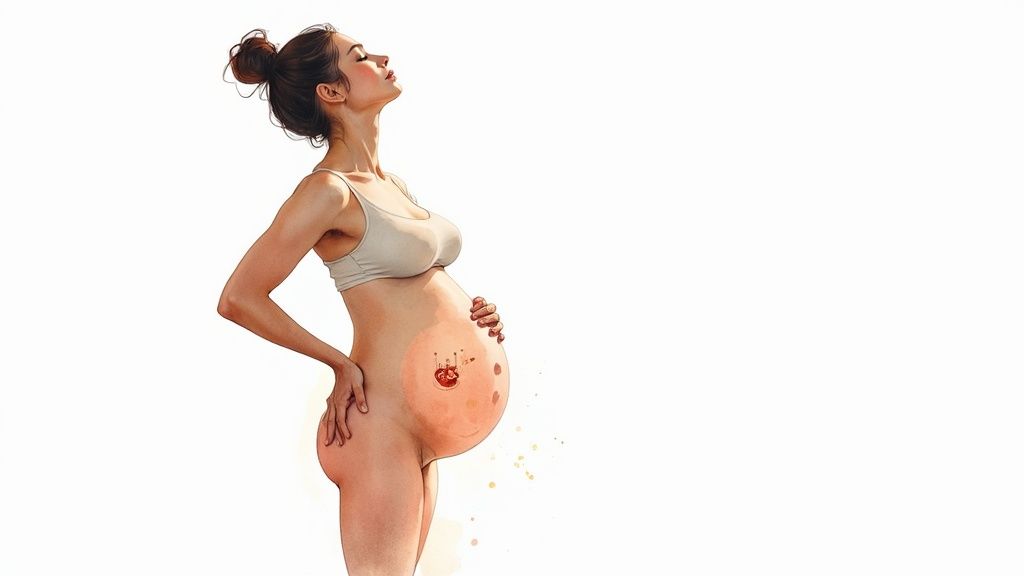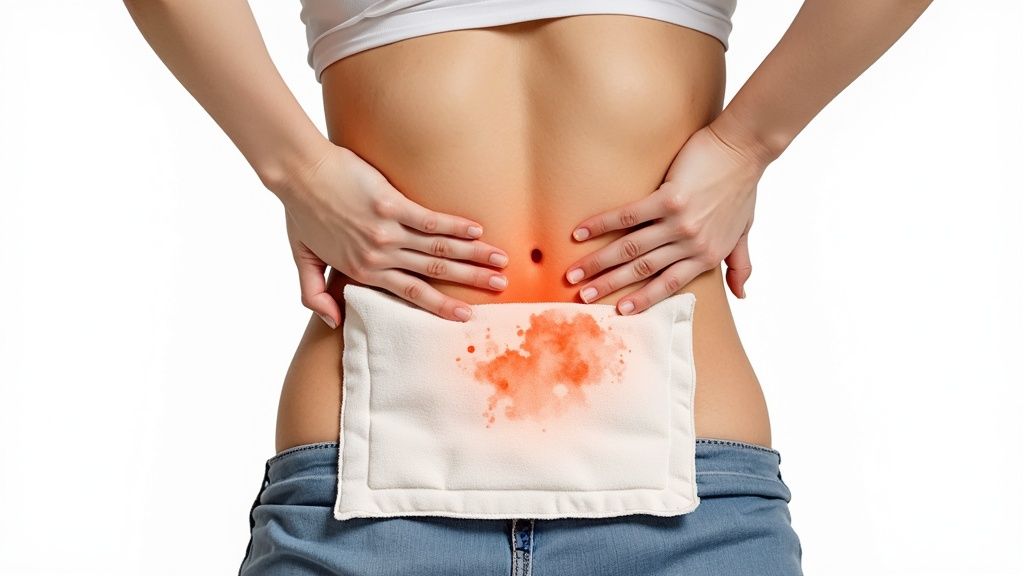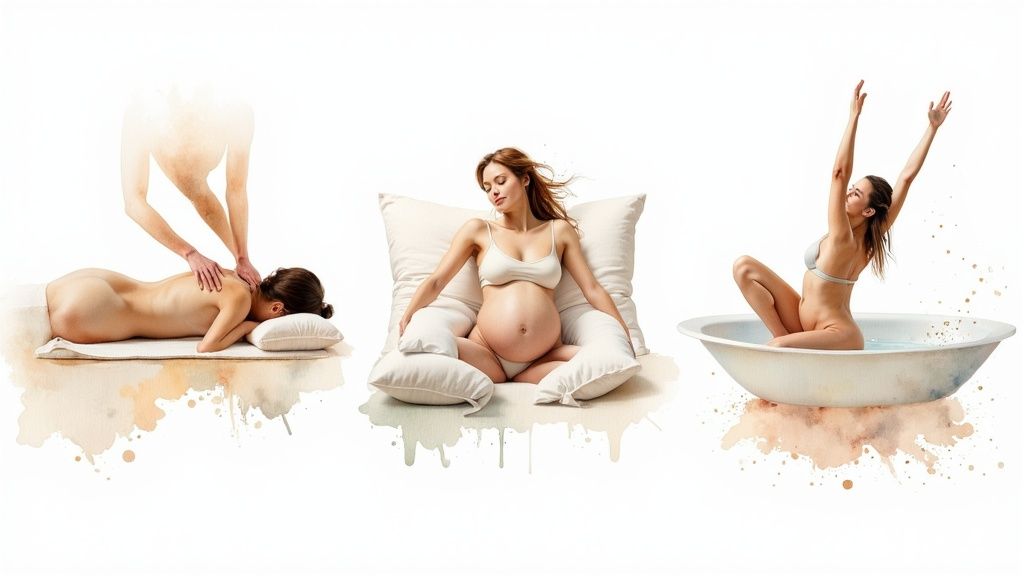Are Heating Pads Safe During Pregnancy? Your Guide
-
When those pregnancy aches and pains kick in, finding quick and safe relief is a top priority. So, can you reach for a heating pad? The short answer is yes—heating pads are generally safe during pregnancy when you need to soothe sore muscles. The real key, however, is how you use them.
It's all about managing the heat to make sure your core body temperature stays in a safe zone.
Your Quick Guide to Using Heating Pads in Pregnancy
Pregnancy is an amazing journey, but let's be honest, it can be tough on the body. Lower back pain, achy hips, and general muscle tension are all part of the package for many expectant mothers. Imagine this: after a long day of carrying extra weight, your lower back is screaming. Instead of reaching for medication, you can apply gentle, localized heat that works wonders by relaxing those tight muscles and boosting blood flow to the area. It’s a fantastic, drug-free way to find comfort.
But safety comes first. The most important rule is to avoid raising your overall body temperature, especially during that critical first trimester. While a heating pad on your back is a world away from soaking in a hot tub or sitting in a sauna, you still need to be smart about it.
This infographic lays out the three simple pillars of safe use: managing the temperature, limiting the time, and being mindful of placement.

As you can see, the guidelines are straightforward: keep the heat low, keep your sessions short, and keep the pad on specific sore spots like your back or hips—never your belly.
To make things even clearer, here's a quick summary of the do's and don'ts.
Heating Pad Safety Quick Guide for Pregnancy
| Guideline | Safe Practice (Do) | Unsafe Practice (Don't) |
|---|---|---|
| Temperature | Use the lowest effective setting. | Never use the highest heat setting. |
| Duration | Limit sessions to 10-15 minutes. | Fall asleep with the heating pad on. |
| Placement | Apply to the back, hips, or legs. | Place the heating pad directly on your abdomen. |
| Barriers | Place a towel or clothing between your skin and the pad. | Apply directly to bare skin. |
| Frequency | Use it only when needed for targeted relief. | Use it constantly throughout the day. |
Following these simple rules helps you get the relief you need without any of the risks.
Heating pads are a great tool for easing that all-too-common pregnancy back pain, but it's crucial to prevent your body from overheating. High core body temperatures, especially early on, have been linked to a higher risk of certain birth defects. For more detailed information, you can find additional guidance about heat therapy during pregnancy at withpower.com.
Why Managing Heat Is Crucial for a Healthy Pregnancy
Let's get straight to the heart of the matter. To understand the safety rules around heating pads, you first need to understand why they exist. The simplest way to think about it is to picture your womb as the perfect, temperature-controlled nursery for your baby. It’s a safe, cozy space, and the biggest concern with any outside heat source—whether it's a hot tub, a fever, or a heating pad—is its ability to raise your core body temperature.

When that internal thermostat gets cranked up too high, you can develop a condition called hyperthermia. This is a real risk, especially during the first trimester when so much critical development is happening. A sustained high core temperature can potentially interfere with the formation of the baby’s neural tube—the structure that eventually becomes the brain and spinal cord.
This is the exact reason there's such a big difference between different kinds of heat exposure. Getting this one concept down is the key to making safe choices.
Localized Heat vs. Core Body Heat
Knowing the difference between localized and systemic heat is what empowers you to use heat therapy the right way.
-
Localized Heat (Safer): This is what a heating pad does. When you place it on your aching lower back, it delivers targeted warmth right where you need it. It’s great for relaxing muscles and boosting blood flow in that specific spot, all without really moving the needle on your overall body temperature.
-
Systemic Heat (Riskier): On the flip side, think about soaking in a hot tub or sitting in a sauna. Your whole body is submerged in heat. This method can raise your core temperature quickly and dangerously, pushing it past the safety threshold.
This is exactly why your doctor will give a thumbs-up to a carefully used heating pad but will strongly advise against hot tubs. One targets a sore spot; the other heats your entire system.
The goal is always to soothe your aches without disrupting the stable, warm environment your baby needs to thrive. Localized, low-level heat achieves this, offering the benefits of heat therapy without the risks.
A warm compress on a sore hip is another perfect example of safe, targeted relief. The warmth stays put, easing your discomfort without putting your baby at risk. Beyond just heating pads, the CDC has noted that general, prolonged heat exposure can increase the risk of certain birth defects and other complications, which just goes to show how important it is to be mindful of heat from all sources. You can also get a deeper understanding by learning about the fundamentals of how heat therapy works.
How to Use a Heating Pad Safely When You're Expecting
Alright, so you’re ready to get some relief from those pregnancy aches and pains. Good news—using a heating pad is straightforward, and once you get the hang of a few simple safety habits, you can relax without a worry in the world.
Let's walk through exactly how to make each session comforting and completely safe for both you and your baby.
The first rule of thumb is to start low and go slow. Your heating pad should feel warm and soothing, never genuinely hot to the touch. Always start with the lowest temperature setting that feels effective. Think of it like a warm bath for a sore muscle—you’re aiming for gentle, comforting warmth, not intense heat.
Here’s another non-negotiable tip: never put the heating pad directly against your skin. Always wrap it in a thin towel or place it over a layer of clothing. This creates a simple but crucial barrier that prevents burns and helps spread the heat out more evenly.
Your Go-To Safety Checklist
Turning these steps into a routine is the best way to ensure you're always being safe. Before you get comfortable, just run through this quick mental checklist.
- Set a Timer: Keep your sessions short and sweet. Stick to about 10-15 minutes at a time. That’s plenty of time to loosen up tight muscles without any risk of raising your core body temperature.
- Target the Right Spot: Place the pad on specific areas of discomfort, like your aching lower back, hips, or shoulders.
- Stay Away From Your Belly: This one is critical. Never, ever place a heating pad directly on your abdomen. The goal is localized relief for your muscles, keeping the heat well away from your baby.
This picture shows the perfect way to position a heating pad to target that all-too-common pregnancy back pain.

As you can see, the heat is focused right where it’s needed while staying away from the front. If you want to dive deeper, this complete guide to heating pad safety offers even more great tips to help you feel confident.
Looking Beyond the Heating Pad for Pregnancy Pain Relief
A heating pad can be a lifesaver for those sharp, localized pains, but it's really just one tool in your pregnancy comfort kit. Think of it this way: you wouldn't use just one spice to make a delicious meal. Creating a well-rounded pain management plan means having a few different strategies to turn to.

Sometimes, the ache you're feeling needs a different approach. A heating pad is fantastic for a tight lower back, but other methods can provide a more holistic sense of relief for your entire body and mind.
Gentle and Effective Alternatives
Let’s walk through a few powerful options that are widely recommended because they're both safe and genuinely effective during pregnancy.
-
Prenatal Massage Therapy: This is so much more than a spa day indulgence. It is a true therapeutic powerhouse for expectant mothers. A massage from a certified prenatal therapist can work wonders on the deep muscle knots that form from carrying extra weight. For instance, skilled hands can release tension in the sciatic nerve area, offering immense relief from hip and leg pain. Beyond that, it gets your circulation moving to help with swelling and even lowers stress hormones. The relief is both physical and mental.
-
Gentle Yoga and Stretching: Movement is medicine, especially during pregnancy. Prenatal yoga is specifically designed to build strength in the muscles supporting your growing belly and ease that all-too-common tension in your back and hips. Think about how a simple "cat-cow" stretch can instantly relieve pressure on your spine. Even a few simple stretches each day can make a world of difference in how mobile you feel.
-
Warm Baths (Not Hot!): Think of a warm bath as a gentle, full-body hug for every sore muscle. The trick is to keep the water comfortably warm—never hot enough to make you sweat or turn your skin red. That way, you get all the soothing benefits without any risk of raising your core body temperature.
A supportive pregnancy pillow can be a total game-changer for sleep and posture. By properly aligning your hips and supporting your belly, it reduces strain on your back and helps you find that elusive comfortable resting position.
Combining these strategies is where the real magic happens. Imagine doing a 15-minute stretching session and then applying targeted heat to your lower back—it’s an incredibly effective one-two punch against pain.
And when it comes to choosing the right pad, you have options. If you're weighing the pros and cons, check out our guide on electric heat pads vs microwavable body heat pads to see which one fits your lifestyle best.
Untangling the Truth About Heat and Pregnancy
When you're pregnant, it feels like everyone has advice for you. It's easy to get overwhelmed by all the "do's" and "don'ts," especially when it comes to old wives' tales about what's safe. Let’s cut through the noise and get to the facts about using heat for those inevitable pregnancy aches.
A common myth you’ll hear is that any heat near your belly is a no-go. That’s a huge oversimplification. The real risk comes from raising your core body temperature, which is why experts warn against soaking in hot tubs or sitting in saunas. These activities heat your entire body, and that’s what can be dangerous for a developing baby.
A heating pad works completely differently. It provides localized heat—gentle, targeted warmth right where you need it, like on your aching lower back. This kind of focused warmth is fantastic for muscle relief and simply doesn't have the power to dangerously elevate your internal temperature when you use it properly.
How Safety and Products Have Changed
Think about it—our understanding of pregnancy safety has come a long way, and so has the technology in the products we use. Yet, some of the old fears tend to stick around long after they've become irrelevant. Take electric blankets, for example.
You might have heard warnings based on older research. A notable study from 1998 did suggest a possible link between using electric blankets around conception and a higher risk of miscarriage. However, the study also noted this connection was weaker when other lifestyle factors were accounted for, and it found no similar risk with heated water beds. If you're curious, you can read the details in the original research on heat sources and pregnancy.
The bottom line is this: today's heating pads and electric blankets are worlds away from the products of decades past. Modern versions come with crucial safety features like automatic shut-offs and multiple temperature settings, giving you complete control. By understanding the difference between localized and immersive heat, you can confidently use a heating pad to find relief without worry.
Your Questions About Pregnancy and Heat Therapy, Answered
It's completely normal to have a few lingering questions, even after you've done your research. Let's walk through some of the most common concerns we hear from expecting parents to make sure you feel confident and safe.
https://www.youtube.com/embed/OVXAPjj6jhI
Can I Put a Heating Pad on My Stomach While Pregnant?
This is probably the most important question, and the answer is a clear and simple no. You should absolutely avoid placing a heating pad directly on your stomach. The whole point of being cautious with heat is to keep your core body temperature stable and prevent any direct, concentrated warmth from reaching your baby.
Stick to using the heating pad on other sore spots like your lower back, achy hips, or tired leg muscles. If you're having cramps or pain in your abdomen, that's a signal to call your doctor for advice, not to self-treat with heat.
Is It Safe to Fall Asleep with a Heating Pad On?
Definitely not. Falling asleep with a heating pad running is a major safety risk. Not only could you get a nasty skin burn (even on a low setting), but the prolonged exposure could slowly raise your core body temperature to a level that's unsafe for your baby.
A great rule of thumb is to look for a heating pad with an automatic shut-off feature. For even more peace of mind, just set a timer on your phone for 10-15 minutes. When it goes off, your heat therapy session is done.
Are Microwaveable Heating Pads a Better Choice Than Electric Ones?
One isn't necessarily "better" than the other; it really boils down to what you prefer and feel most comfortable managing. Both can be perfectly safe when used correctly.
-
Microwaveable Pads: These are often filled with natural materials like rice or flaxseed. They come with a built-in safety advantage: they start cooling down the moment you take them out of the microwave. This design naturally prevents you from getting too much heat for too long. Just be sure to test the temperature on your wrist before placing it on your body.
-
Electric Pads: These give you steady, consistent heat that you can adjust. The trade-off is that you have to be more mindful of the settings and your timer to stay within that 15-minute safe window.
Ultimately, the best choice is the one you can use confidently while following all the safety rules.
When Should I Call My Doctor About Aches and Pains?
While some discomfort is a standard part of the pregnancy experience, you should always give your doctor a heads-up before trying any new form of pain relief, including a heating pad.
It's especially important to get in touch with them right away if your pain is severe, doesn't go away, or comes with other symptoms like fever, bleeding, or cramping that feels unusual. Your doctor can rule out any underlying problems and create the safest pain relief plan for both you and your baby.
For safe, drug-free relief you can count on, explore the U.S.-made microwavable heat therapy solutions from SunnyBay. Designed for targeted comfort, our wraps and pads provide gentle, soothing warmth for your back, hips, and shoulders. Find your perfect pain relief companion at the official SunnyBay website.
